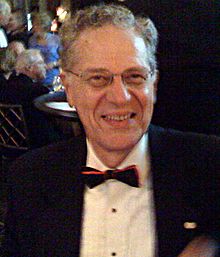Joseph Hooton Taylor Jr. facts for kids
Quick facts for kids
Joseph Hooton Taylor Jr.
|
|
|---|---|

Taylor in 2008
|
|
| Born | March 29, 1941 Philadelphia, Pennsylvania, U.S.
|
| Nationality | American |
| Alma mater | Haverford College Harvard University |
| Known for | Pulsars, WSJT-X |
| Awards | Dannie Heineman Prize for Astrophysics (1980) Henry Draper Medal (1985) Magellanic Premium (1990) John J. Carty Award (1991) Wolf Prize in Physics (1992) Nobel Prize in Physics (1993) |
| Scientific career | |
| Fields | Physics |
| Institutions | Princeton University University of Massachusetts Amherst Five College Radio Astronomy Observatory |
| Doctoral students | Russell Alan Hulse, Victoria Kaspi, Ingrid Stairs |
Joseph Hooton Taylor Jr. (born March 29, 1941) is an American astrophysicist. He won the Nobel Prize in Physics in 1993. He shared this award with Russell Alan Hulse. They were honored for finding a new type of pulsar. This discovery helped scientists learn more about gravitation.
Contents
Early Life and Education
Joseph Taylor was born in Philadelphia, Pennsylvania. He grew up in Cinnaminson Township, New Jersey. From a young age, he showed a great talent for math.
He earned his first degree in physics from Haverford College in 1963. Later, he received his Ph.D. in astronomy from Harvard University in 1968. After Harvard, Taylor worked at the University of Massachusetts Amherst. He became a professor there. He also helped lead the Five College Radio Astronomy Observatory.
Around the time he finished his Ph.D., another scientist, Jocelyn Bell, found the first radio pulsars. This discovery sparked Taylor's interest in these amazing objects.
Discovering Pulsars
After his studies, Taylor went to the National Radio Astronomy Observatory. He helped find some of the first pulsars discovered outside of Cambridge, England. Since then, he has spent his career studying pulsars.
The First Binary Pulsar
In 1974, Taylor and Russell Hulse made a huge discovery. They found the first pulsar that was part of a binary system. This means it was orbiting another star. They named it PSR B1913+16. They found it using the Arecibo Observatory in Puerto Rico.
This pulsar was also the first "recycled" pulsar. These are Neutron stars that spin very fast. They get this speed from material pulled from their companion star.
Testing Einstein's Theory
The two stars in this binary system orbit each other very closely. Their orbit slowly shrinks over time. This happens because they lose energy by sending out gravitational radiation. This radiation is like ripples in space-time.
Albert Einstein's General Theory of Relativity predicted this energy loss. Taylor and his team studied the pulsar for over 30 years. Their measurements matched Einstein's predictions almost perfectly. This was the first strong proof that gravitational radiation exists.
Today, many other binary pulsars are known. Their studies also confirm Taylor's findings. For this groundbreaking work, Taylor and Hulse won the Nobel Prize in Physics in 1993. In 1980, Taylor moved to Princeton University. He taught physics there until he retired in 2006.
Amateur Radio Hobby
Joseph Taylor got his amateur radio license when he was a teenager. This hobby helped lead him into the field of radio astronomy. He is well-known among amateur radio enthusiasts. His call sign is K1JT.
In 2010, he used the Arecibo Radio Telescope for an amateur radio project. He bounced radio signals off the Moon to talk with other amateur radio operators worldwide. This is called moonbounce.
Taylor also helped create special computer programs for amateur radio. These include WSPR and WSJT. These programs help people communicate over long distances. They work even when signals are very weak. This is useful for moonbounce or meteor scatter communication. He also helped create the popular FT8 mode.
Honors and Awards
Joseph Taylor has received many awards for his scientific work.
- Dannie Heineman Prize for Astrophysics (1980)
- Henry Draper Medal (1985)
- Magellanic Premium (1990)
- Albert Einstein Medal (1991)
- John J. Carty Award for the Advancement of Science (1991)
- Wolf Prize in Physics (1992)
- Nobel Prize in Physics (1993)
- Golden Plate Award of the American Academy of Achievement (1995)
- Karl Schwarzschild Medal (1997)
An asteroid, 81859 Joetaylor, was named after him in 2006. This was to honor his retirement from Princeton University. Taylor has also served on many important science committees.
See also
 In Spanish: Joseph Hooton Taylor Jr. para niños
In Spanish: Joseph Hooton Taylor Jr. para niños
- Harold E. Taylor, brother – physicist

